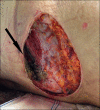Gastric Ulcer and Perforation due to Mucormycosis in an Immunocompetent Patient
- PMID: 31737696
- PMCID: PMC6791637
- DOI: 10.14309/crj.0000000000000154
Gastric Ulcer and Perforation due to Mucormycosis in an Immunocompetent Patient
Abstract
Mucormycosis is a rare and life-threatening fungal infection that is associated with high mortality in immunocompromised individuals. Although it most commonly affects lungs and paranasal sinuses, cases of invasive mucormycosis of the gastrointestinal tract have also been reported. Gastrointestinal mucormycosis (GIM) is most commonly found in the stomach, colon, and ileum. Etiologies of GIM include ingestion of spores and penetrating abdominal trauma, causing mucocutaneous disruption. We present a case of an immunocompetent man who presented to our hospital after a gunshot wound to the abdomen. His hospital course was complicated with the development of invasive GIM in the form of a large gastric ulcer, which caused gastrointestinal bleeding and eventually perforation.
© 2019 The Author(s). Published by Wolters Kluwer Health, Inc. on behalf of The American College of Gastroenterology.
Figures



References
Publication types
LinkOut - more resources
Full Text Sources

